What Is Sticky Rice?
Though more commonly associated with Thai food, glutinous rice, more commonly known as sticky rice, is a staple of East Asia — specifically Laos, Thailand’s northern neighbor.
Though most varieties contain the two main components of starch, amylose, and amylopectin, sticky rice only contains amylopectin. So when hot water interacts with the amylopectin-ridden rice, the rice becomes soft and sticky. The rice is often served as a side or even as part of the main dish, such as sticky rice balls or the base of a stir-fry.

How To Cook Sticky Rice
To make sticky rice at home, it’s important to obtain this amylose-absent rice, or else the rice will not stick together properly when cooked. Make sure your package of rice is labeled “sticky rice,” “sweet rice,” or “glutinous rice.”
There are a couple different ways you can prepare sticky rice depending on what you prefer and the preparation means you have in your kitchen. Here are some common methods:
Steamed
Steaming is the traditional method to use when making sticky rice. It’s a simple process, but must be done well before your meal time:
- Put your desired amount of rice into a large pot
- Cover the rice with 2 or 3 inches of lukewarm water
- Let the rice sit for 6 to 25 hours. The longer the rice sits in the water, the stickier and tastier the final product will be.
- Drain the rice and pour into a steamer basket
- Boil 2 or 3 inches of water in a wok or pot, then put the steamer basket over it. Make sure the rice is not touching the water.
- Cover and steam for 20 minutes
- Stir the rice, then steam for another 5 minutes

Doraemon9572/Shutterstock
On The Stove
Though not the traditional method, to make sticky rice on your stove you don’t need anything fancy like a steamer — all you need is a single large pot. This method is also faster than steaming, as you don’t need to let the rice sit in water for nearly as long. Here are the steps:
- Put two cups of rice and three cups of water into a pot
- Let the rice soak from anywhere between half an hour to 4 hours
- Add half a teaspoon of salt and stir it in
- Over high heat, bring the pot to a boil
- Turn the heat to medium low and cover the pot, but leave the lid askew so it can ventilate on one side
- Cook for 10 minutes, making sure not to stir the rice during this step
- Check to see if the rice has absorbed all the water. You can do this by taking a fork and pulling the rice out of the center of the pot. If there is still water, cook for another 5 minutes.
- Remove the pot from the heat, place the lid securely on the pot (with no ventilation) and let the rice sit for 10 minutes before serving

katueng/Shutterstock
In A Rice Cooker
This is the simplest way to make sticky rice:
- Measure two cups of rice and two and a half cups of water into the rice cooker
- Let sit for 30 minutes to 4 hours
- Put in half a teaspoon of rice
- Turn on the rice cooker and cook for 15 to 20 minutes
- Let the rice sit for 5 minutes before serving

Teerasak Ladnongkhun/Shutterstock
How To Use Sticky Rice
Once you’ve made your sticky rice, the possibilities for dishes are endless. Sticky rice is a great complement for sweet and spicy foods, from everything between chicken and steak to mango. The dish can be served with Korean, Thai, Vietnamese, Chinese or Japanese cuisine. Here are some common ways to incorporate sticky rice into a meal:
Savory Sticky Rice
This rice is similar to stir fry, with sticky rice’s signature chewy texture. Play around with the ingredients until you make the perfect concoction of veggies.

vanillaechoes/Shutterstock
Thai Sweet Sticky Rice With Mango
This authentic Thai dessert is a sweeter take on sticky rice. Just use coconut milk, sugar, salt and tapioca starch to make a sauce and pour it over the fruit and rice.

TONG4130/Shutterstock
Sticky Rice Dumplings
Instead of slapping the sticky rice on the side of the main dish, make it part of the main dish in this tasty variation. It’s a bit more complex than the previous recipes, but is a delicious Shanghai staple.

leungchopan/Shutterstock
